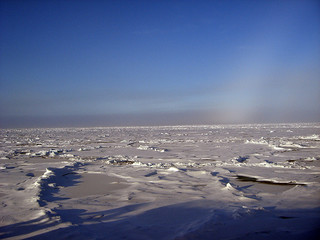MultipleOrganisms.Net 
Photo courtesy of the United States Government
Habitat
Photo courtesy of NASA Goddard Photo and Video
Geographic Locations and Distribution
Blue whales are found in every ocean, ranging from the equator to the ice edges in the North and South poles.
Southern Hemisphere
Antarctic blue whales, B. musculus intermedia, are found near Antarctica during the summer months. Captures off the coast of Chili and Namibia suggest they migrate north in the winter. The population near the Chilean coast has declined to ten percent of the original population number before 1998. Antarctic blue whales have faced an approximated 99% decline since whale hunting began.
Photo courtesy of the NOAA
Indian Ocean
B. musculus brevicauda are most abundant near the west coast of Australia through Indonesia and into the Southern Indian Ocean north of 55 ° S year-round. From 2002-2010 a negative trend of blue whale communication in the Indian Ocean, a decrease in .12 Hz per year, was concluded. These findings suggest the blue population in the Indian Ocean is dropping.
Northern Hemisphere
Blue whales of the North Atlantic and Pacific, B. musculus musculus, are found near the coast of Iceland and Norway, in addition to the east coast of Canada near the waters of Newfoundland and in the Gulf of St. Lawrence. In the winter months B. musculus musculus migrates south in the Atlantic, staying above the equator. Blue whales are most abundant in the Eastern Pacific, ranging from the coast of Alaska to the Costa Rica Dome. The Costa Rica Dome provides a year-round home for the B. musculus musculus subspecies. Blue whales migrate to the Costa Rica Dome in the winter months to obtain food and reproduce.
Ecological Niche
Balaenoptera musculus shares its environment with thousands of marine organisms, including all cetaceans. Of these organisms, blue whales in almost all cases only eat krill. Additionally, the only known attacker of the blue whale in the ocean is the killer whale. Stay tuned for Interactions. To examine the structural modification, see Adaptations.
04/22/2012 12:59 PM


